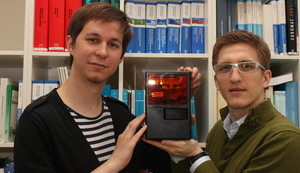Smallest 3D Printer in the World
on

Printers capable of producing three-dimensional objects have been available for years. However, at the Vienna University of Technology, a printing device has now been developed that’s smaller, lighter and cheaper than ordinary 3D printers. With this kind of printer, everyone could produce small, tailor-made 3D objects at home, using building plans from the Internet – and this could save money for expensive custom-built spare parts.
Several scientific fields have joined up to design a 3D printer. The device was assembled by mechanical engineers in the research group of professor Jürgen Stampfl, but also the chemical research by the team of professor
The basic principle of the 3D-printer is quite simple: The desired object is printed in a small tub filled with synthetic resin. The resin has a very special property: It hardens precisely where it is illuminated with intense beams of light. Layer for layer, the synthetic resin is irradiated at exactly the right spots. When one layer hardens, the next layer can be attached to it, until the object is completed. This method is called “additive manufacturing technology”.
This method is not designed for large-scale production of bulk articles – for which cheaper alternatives are available. The advantage of additive manufacturing is the fact that is offers the possibility to produce tailor-made, individually adjusted items. The prototype of the printer is no bigger than a carton of milk, it weighs
The printer’s resolution is excellent: The individual layers hardened by the light beams are just a twentieth of a millimetre thick. Therefore, the printer can be used for applications which require extraordinary precision – such as construction parts for hearing aids. Unlike previous models, the printer at TU Vienna uses light emitting diodes, with which high intensities of light can be obtained at very well-defined positions.


Discussion (0 comments)